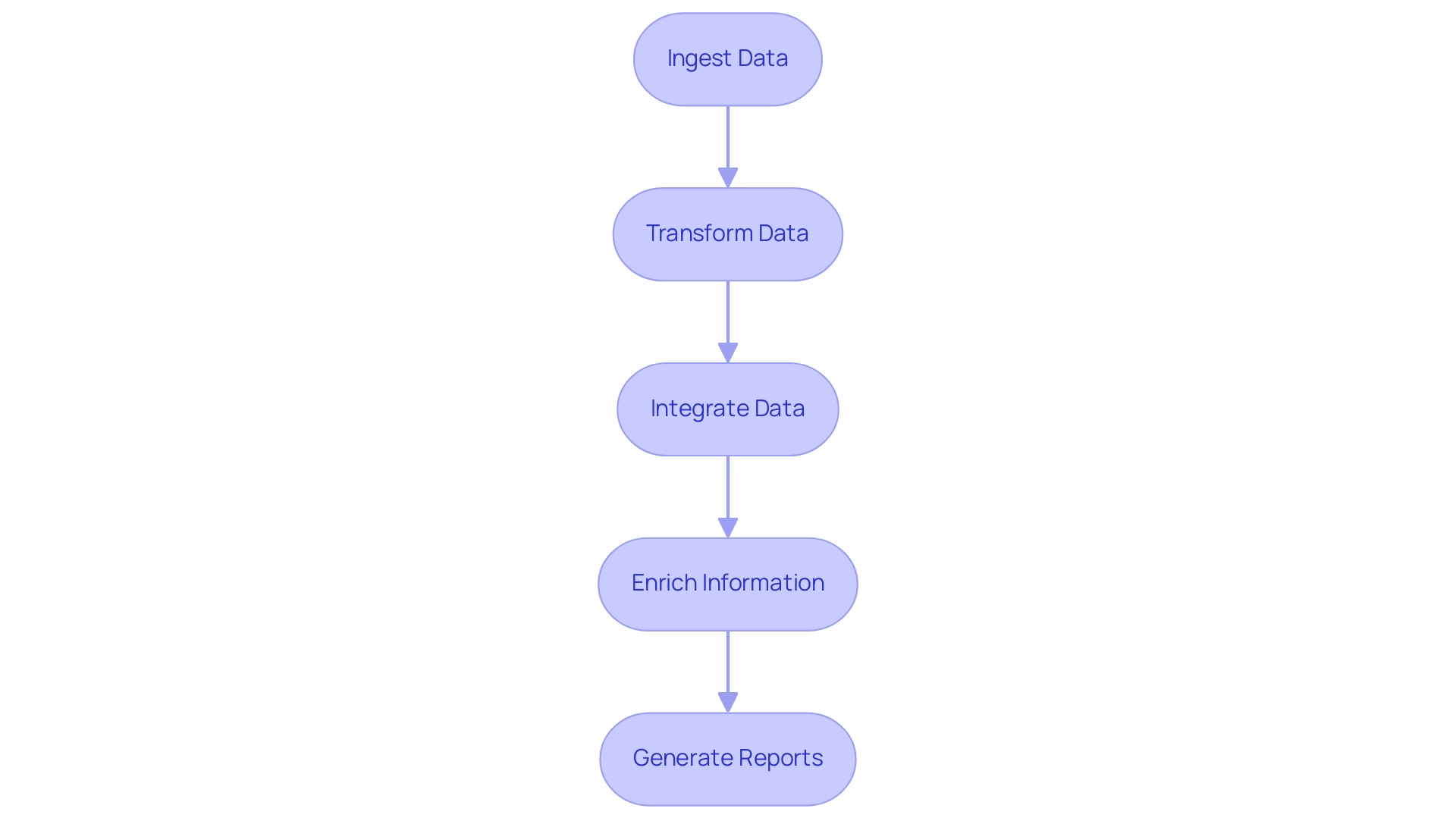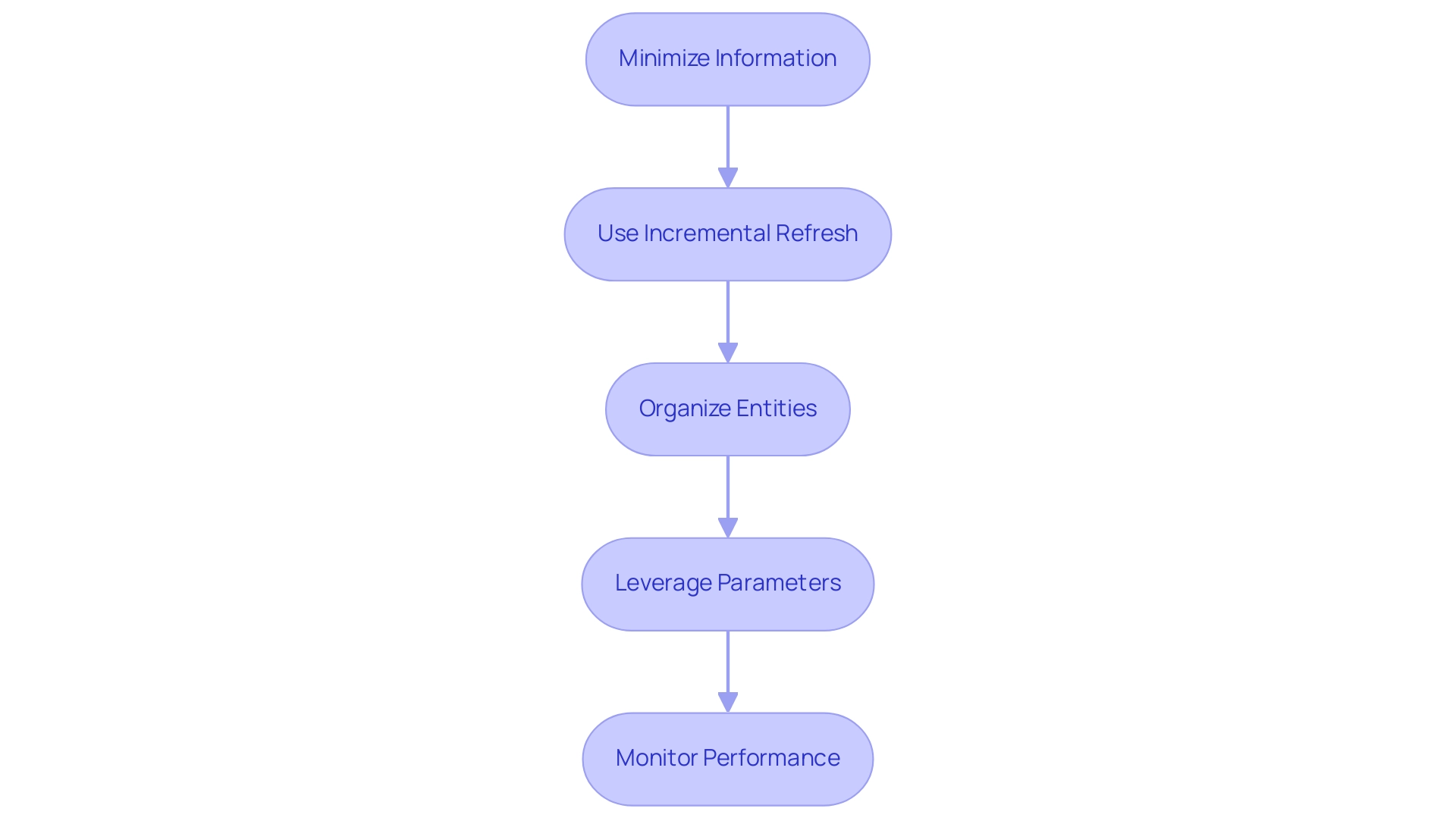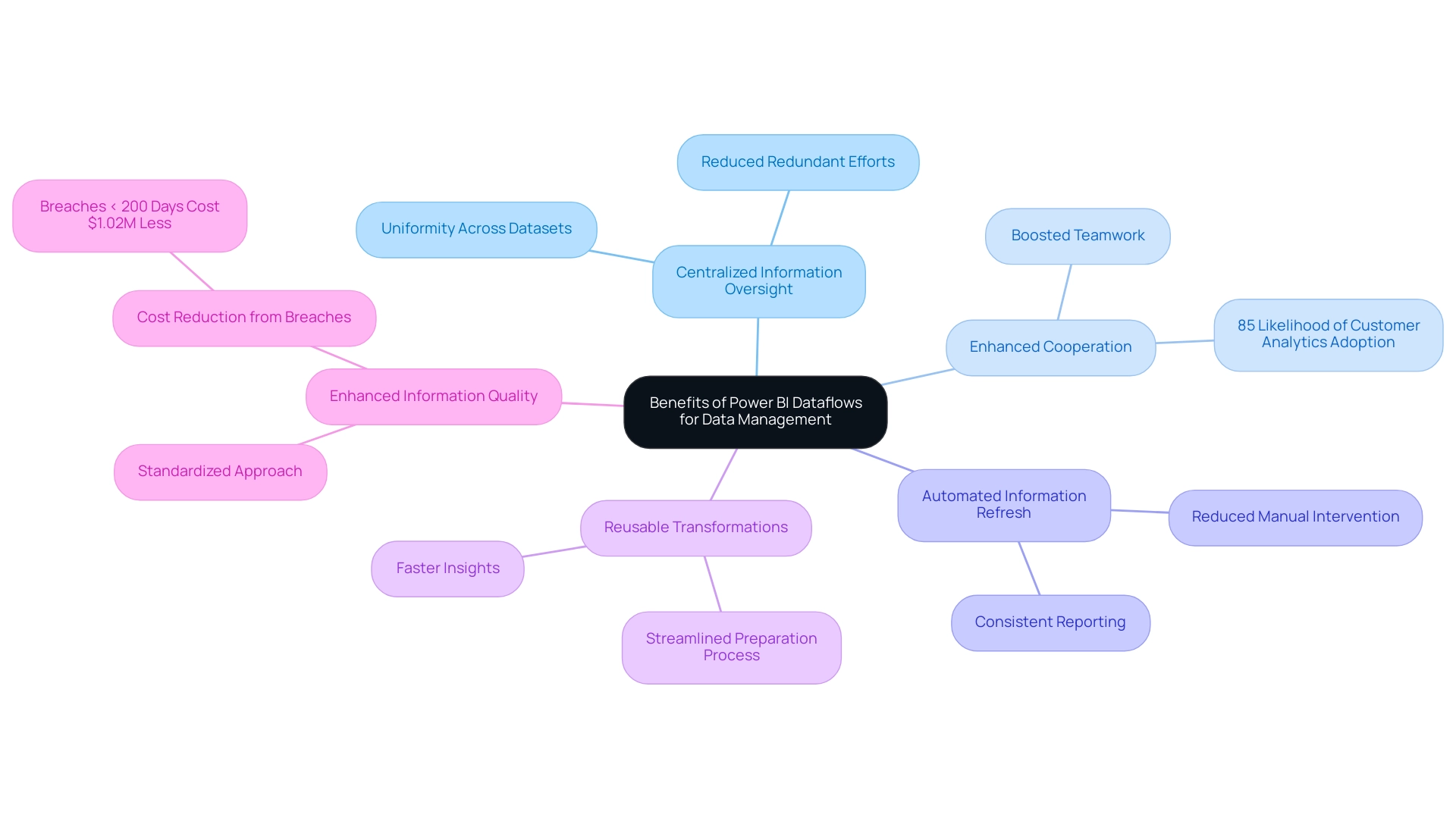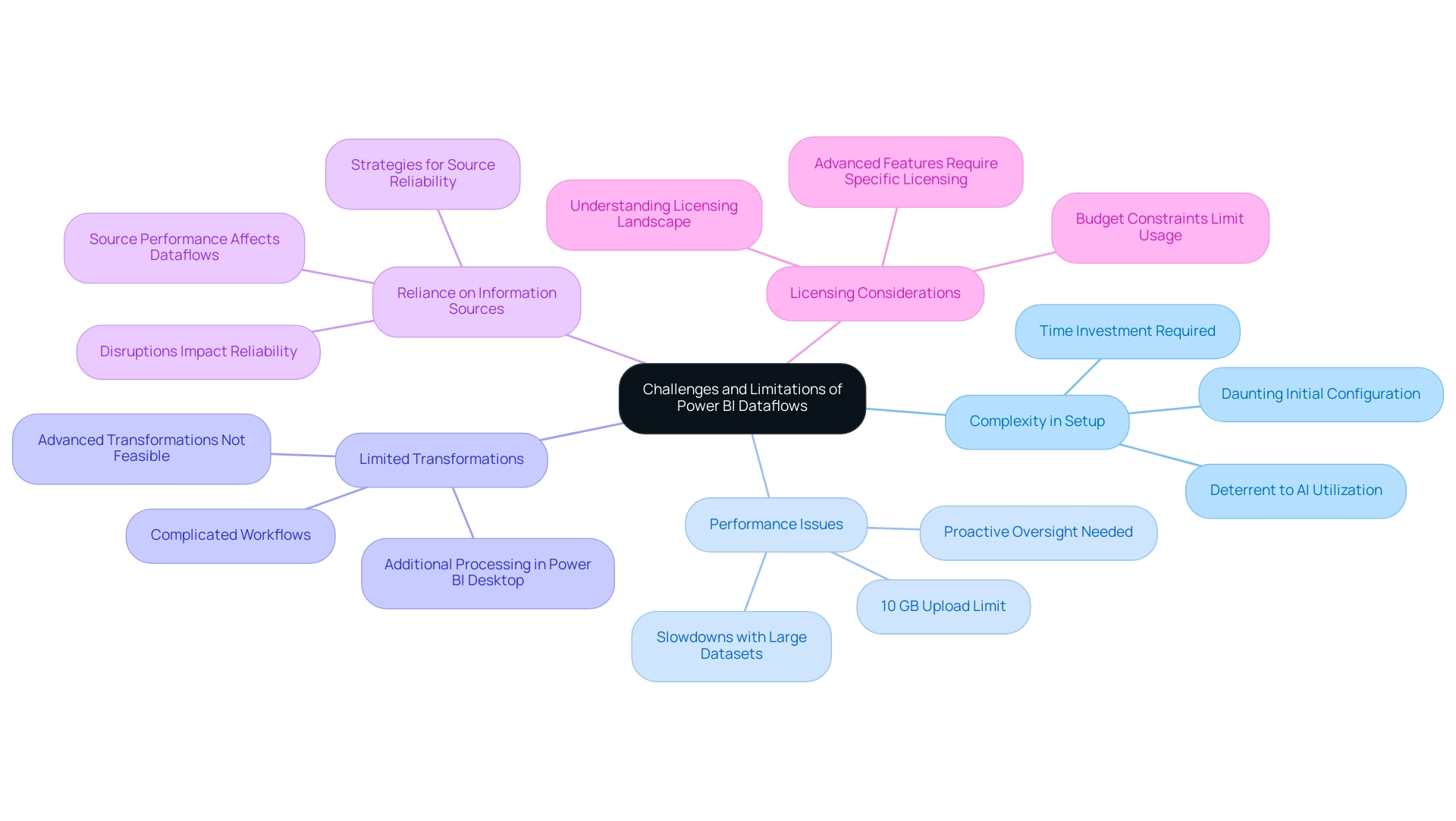Introduction
In the rapidly evolving landscape of data management, Power BI Dataflows emerge as a transformative solution for organizations seeking to harness their data effectively. As businesses grapple with the complexities of data preparation and analysis, these cloud-based tools offer a streamlined approach to ingesting, transforming, and integrating data, paving the way for insightful reporting.
However, the journey to optimizing Power BI Dataflows is not without its challenges. From establishing clear roles to implementing best practices, organizations must navigate a series of strategic steps to unlock the full potential of their data initiatives.
This article delves into the essentials of Power BI Dataflows, providing a comprehensive guide to creating, managing, and maximizing their benefits, ultimately empowering teams to make informed decisions and drive operational efficiency.
Introduction to Power BI Dataflows: What You Need to Know
Powerful BI workflows act as an effective cloud-based information preparation tool, allowing users to efficiently ingest, transform, integrate, and enrich information for insightful reporting and analysis. In today’s data-rich environment, failing to extract meaningful insights can leave your business at a competitive disadvantage. Establishing roles and responsibilities is essential for a successful BI initiative, as it guarantees stakeholder involvement and clarity throughout the information handling process.
By focusing on information management tasks, these workflows enable the development of reusable transformations, ensuring consistency across various reports. The integration of dataflow Power BI within the BI ecosystem is essential; they automate preparation processes, significantly lowering manual efforts and improving collaboration among teams. Moreover, the challenges associated with leveraging insights from BI dashboards—such as time-consuming report creation and data inconsistencies—can be addressed through our tailored BI services.
Notably, our 3-Day Business Intelligence Sprint allows for rapid development of professionally designed reports, while the General Management App enhances overall management and review processes. As Tajammul Pangarkar, CMO at Prudour Pvt Ltd, aptly notes, ‘Understanding tech trends is essential for organizations to utilize tools like BI effectively.’ Utilizing Query, dataflow Power BI enables users to apply familiar transformation techniques without needing extensive technical knowledge, which empowers organizations to leverage their information more effectively.
This process of transforming raw data into actionable insights is central to driving informed decision-making. Furthermore, with Automate, businesses can streamline workflow automation, ensuring a risk-free ROI assessment and professional execution. Significantly, 80% of organizations utilizing cloud-based BI have witnessed enhanced scalability, highlighting the influence of dataflow Power BI on operational efficiency and informed decision-making.

Step-by-Step Guide to Creating and Managing Power BI Dataflows
Establishing a dataflow Power BI in Business Intelligence is a simple procedure that enables organizations to efficiently handle their information while utilizing Robotic Process Automation (RPA) to streamline manual workflows. This integration not only boosts operational efficiency but also enhances data-driven insights crucial for business growth by reducing errors and freeing up team resources for more strategic tasks. Follow these steps to set up your Dataflow:
- Open BI Service: Begin by navigating to
https://app.bi.comand log in with your credentials. - Access Workspaces: On the left pane, click on ‘Workspaces’ and select the workspace you wish to use.
- Create Dataflow: Click the ‘Create’ button, then choose ‘Dataflow’ from the options.
- Define New Entities: Select ‘Add new entities’ and choose your information source, whether it be SQL Server, Excel, or another option.
- Transform Data: Utilize the Power Query Editor to apply transformations. This might involve filtering rows, renaming columns, or merging tables to customize the information to your needs.
- Save and Refresh: Save your Dataflow and establish a refresh schedule to keep your information current.
- Access Dataflow in BI Desktop: You can now reach this Dataflow in BI Desktop to create insightful reports.
By following these steps, users can create dataflow Power BI that not only improve information oversight but also align with RPA strategies for greater operational efficiency. The BFSI sector is expected to witness the quickest expansion in the business intelligence market from 2023 to 2032, according to Inkwood Research, making efficient information handling in tools such as BI crucial for operational success. With more than 10,000 firms utilizing BI within the 1,000 to 4,999 staff range, its scalability and adaptability are clear, offering a strong solution for mid-sized organizations seeking to enhance their processes.
Additionally, as organizations navigate the challenges posed by the rapidly evolving AI landscape, the significance of data management tools becomes increasingly apparent. Microsoft’s recent acquisition of C3.ai for $6.9 billion underscores the growing importance of utilizing BI for maximizing operational efficiency.

Best Practices for Optimizing Your Power BI Dataflows
To enhance the performance of your dataflow Power BI and leverage the capabilities of Robotic Process Automation (RPA), implementing the following best practices is crucial:
-
Minimize Information:
Focus on extracting only the essential information required for your reports. This approach not only improves performance but also reduces load times, ultimately leading to more efficient operations.
RPA can automate the extraction process, ensuring that only the necessary information is pulled, which is especially important as spending on non-cloud infrastructure is projected to grow at a CAGR of 2.3% over the 2021-2026 period. -
Use dataflow Power BI with incremental refresh:
By employing dataflow Power BI’s incremental refresh, you can manage large datasets more effectively, ensuring that only the information that has changed is reloaded. RPA can automate the incremental refresh process, significantly cutting down on processing times and system resource usage, making it a vital strategy for organizations handling vast amounts of data. -
Organize Entities:
Structuring your dataflow Power BI with clear naming conventions and logical groupings can greatly facilitate easier management and collaboration among team members. RPA can assist in maintaining this organization by automating updates and adjustments, reducing the likelihood of errors. Leading marketers are 1.6 times more likely to believe that open access to information results in higher performance, highlighting the benefits of organized structures. -
Leverage Parameters:
Utilize parameters for dynamic filtering of information sources in dataflow Power BI. RPA can enhance this adaptability by automating parameter adjustments based on real-time information analysis, allowing for more tailored dataflow configurations that can adjust to varying project requirements without significant rework. -
Monitor Performance:
Regularly reviewing dataflow Power BI performance metrics is essential to identify and troubleshoot bottlenecks or inefficiencies. RPA can play a crucial role in continuous monitoring and alerting of performance issues, ensuring proactive oversight. As 85% of Singaporean business leaders recognize, effective information handling can significantly enhance decision-making and decrease risks linked to operational delays. Monitoring performance can help avoid the high costs associated with prolonged breaches of information, which average $1.02 million higher for incidents lasting beyond 200 days.
Implementing these best practices not only optimizes your BI workflows but also positions your organization to better handle unforeseen challenges posed by the rapidly evolving AI landscape, supported by the strategic use of RPA.

Benefits of Using Power BI Dataflows for Data Management
Utilizing BI processes offers numerous benefits for organizations seeking to improve their information handling strategies, particularly alongside Robotic Process Automation (RPA):
-
Centralized Information Oversight: The use of dataflow Power BI in BI Data streams enables a unified method for information oversight, guaranteeing uniformity across multiple datasets while reducing redundant efforts. This centralization is crucial for maintaining information integrity and reliability, particularly as RPA can automate the entry and management processes, significantly reducing errors and enhancing operational efficiency.
-
Enhanced Cooperation: With Power BI workflows, multiple users can effortlessly contribute to processes, boosting teamwork and facilitating the sharing of insights across various departments. As organizations increasingly utilize RPA, the collaborative environment becomes crucial, particularly with statistics showing that 85% of organizations are likely to incorporate customer analytics using AI/ML and predictive capabilities into their strategies in the next 12 months.
-
Automated Information Refresh: Dataflow Power BI enables the establishment of automated refresh schedules, ensuring that reports are consistently based on the most recent information without necessitating manual intervention. This feature not only saves time but also reduces the risk of errors associated with outdated information, further supported by RPA’s ability to efficiently handle routine tasks, thereby freeing up teams for more strategic initiatives.
-
Reusable Transformations: Users can create transformations once and apply them across various reports. This capability streamlines the preparation process and significantly reduces workload, allowing teams to focus on analysis rather than repetitive tasks. RPA can enhance this process by automating the execution of these transformations, thus enabling faster insights and reducing the manual effort involved.
-
Enhanced Information Quality: Through the application of consistent transformations, the dataflow Power BI workflows promote a standardized approach to information quality across the organization. This is especially vital as organizations acknowledge the financial consequences of breaches; IBM indicates that breaches with a lifecycle shorter than 200 days incur costs that are, on average, $1.02 million lower than those extending beyond that timeframe. Ensuring information integrity through analytical processes, aided by RPA, can help reduce these risks and enhance overall information quality.
In the context of the EDM market, where large enterprises hold 69.50% of the market share, the advantages of such analytical processes for centralized information oversight and improved collaboration are paramount. These advantages are particularly pertinent for organizations of all sizes aiming to optimize their information strategies in 2024, as they can significantly enhance operational efficiency and decision-making across various scales of business operations.

Challenges and Limitations of Power BI Dataflows
While Power BI Dataflows present numerous benefits for data management, it is crucial to recognize the challenges that may arise, particularly in the context of poor master data quality and the barriers to effective AI adoption:
-
Complexity in Setup: The initial configuration of data streams can be daunting for newcomers, often requiring a significant investment of time to familiarize oneself with the interface and diverse functionalities. This complexity can deter organizations from fully utilizing AI capabilities, leading to missed opportunities. However, understanding the accessibility of AI technology and its application in dataflow powerbi can help alleviate these concerns, making integration more manageable.
-
Performance Issues: Handling large datasets or poorly optimized Dataflows can lead to noticeable slowdowns. Users must engage in proactive oversight to ensure optimal performance and responsiveness. For example, the BI Premium license restricts file uploads to 10 GB, which can complicate management for larger datasets, further worsening issues related to inconsistent quality.
-
Limited Transformations: Advanced information transformations may not be feasible directly within Dataflows. This limitation necessitates additional processing in Power BI Desktop, especially regarding dataflow Power BI, potentially complicating workflows and making it harder to extract actionable insights for informed decision-making. Customized AI solutions can aid in streamlining these processes, enhancing the overall efficiency of information management.
-
Reliance on Information Sources: The functionality of these workflows is closely linked to the availability and performance of the originating information. Any disruptions or inefficiencies at the source can directly affect Dataflow operations, complicating the process of generating reliable business intelligence. Organizations should consider strategies to ensure dataflow powerbi source reliability as part of their AI integration efforts.
-
Licensing Considerations: Certain advanced features within BI Dataflows may require specific licensing arrangements. This can pose a barrier for organizations with budget constraints, limiting their ability to fully leverage the tool and hindering their overall efficiency. Grasping the licensing landscape is essential for maximizing the potential of dataflow powerbi, BI, and AI technologies.
As Liu Yang notes, “If this post helps, then please consider Accept it as the solution to help the other members find it more quickly,” emphasizing the importance of community support in navigating these challenges.
Furthermore, the case study titled ‘Modeling Limitations in Power BI‘ illustrates user dissatisfaction with the modeling experience. By examining the implications of these challenges, organizations can better appreciate the necessity for enhancements and the potential of tailored solutions in overcoming quality issues.
Overall, while these challenges are significant, understanding them equips users to develop strategies that can mitigate their impact, ultimately enhancing their data management capabilities and enabling more effective AI integration.

Conclusion
Power BI Dataflows represent a pivotal advancement in data management, offering organizations a powerful tool to streamline their data preparation and analysis processes. By enabling efficient ingestion, transformation, and integration of data, these cloud-based solutions empower teams to derive actionable insights that drive informed decision-making and enhance operational efficiency. The article outlines essential steps for creating and managing Dataflows, emphasizing the importance of establishing clear roles and responsibilities to foster stakeholder engagement and effective collaboration.
Implementing best practices, such as:
- Minimizing data loads
- Leveraging incremental refresh
- Organizing entities
further optimizes the performance of Power BI Dataflows. These strategies, complemented by Robotic Process Automation (RPA), not only enhance data quality but also reduce manual efforts, allowing teams to focus on strategic initiatives rather than repetitive tasks. The benefits of centralized data management and improved collaboration are crucial for organizations aiming to stay competitive in today’s data-driven landscape.
However, it is essential to acknowledge the challenges that accompany the use of Power BI Dataflows, including:
- Complexities in setup
- Performance issues with large datasets
By understanding these limitations and employing tailored solutions, organizations can navigate potential obstacles and unlock the full potential of their data management initiatives. As businesses continue to evolve in the face of technological advancements, embracing tools like Power BI Dataflows will be vital for cultivating a culture of data-driven decision-making and operational excellence.

